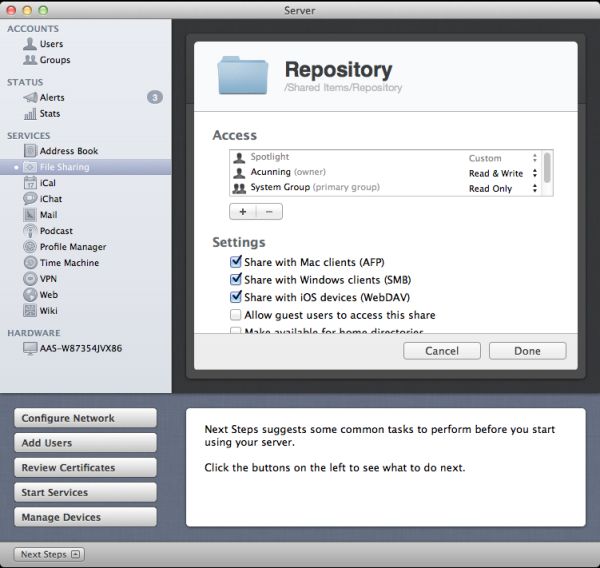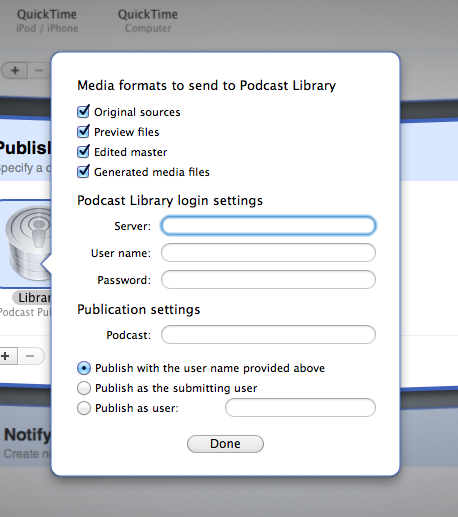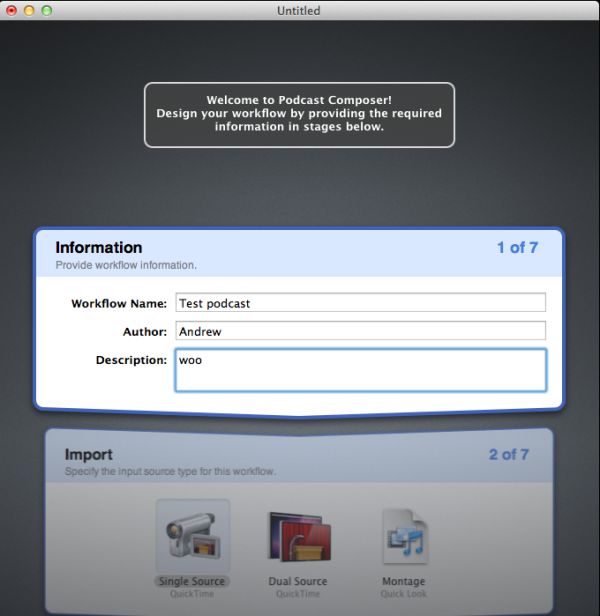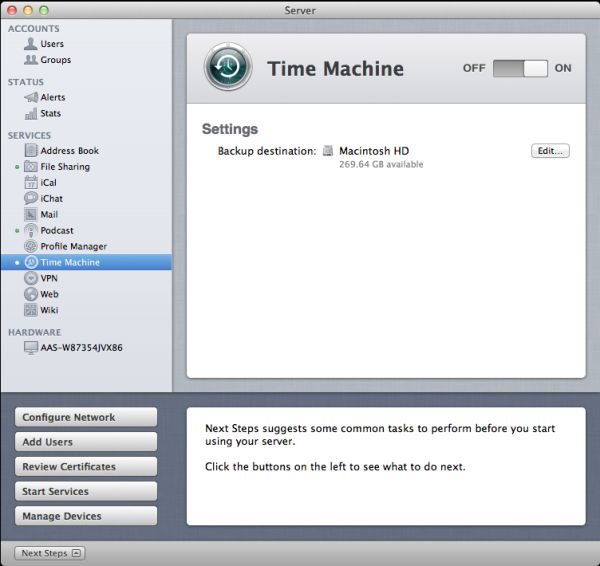In-Depth with Mac OS X Lion Server
by Andrew Cunningham on August 2, 2011 8:00 AM ESTFile Sharing

Click the edit button, and you can control access permissions to each individual folder, as well as what protocols the folders are offered over - AFP for OS X clients, SMB for Windows clients, and WebDAV for iOS clients (many apps, the iOS iWork apps among them, can only connect via WebDAV - this useful new feature is one of the few that could truly justify OS X Server in a home environment).
You may remember from our Lion review that Apple changed up its SMB implementation in Lion. As in the client version, the change shouldn’t affect most server users either: Windows 7, Vista, and XP clients can still connect to SMB shares hosted by OS X Server without issue.
Podcast and Podcast Composer
The Podcast service (which needs the Wiki service to be fully functional, it would seem) works together with the Podcast Composer (another of the Server Admin Tools) to provide end-to-end podcast recording, editing, and hosting. Turn on the Podcast service (and the Wiki service if you haven't already) and then fire up the Podcast Composer.
This program is pretty straightfoward - it builds a podcasting workflow, asking you what you'd like to use to record, what file formats you'd like to export to when done, what fades and wipes you'd like to use - everything a newbie podcaster needs, really (though this does seem to be tailored more to internal-use-only recordings and less to something you'd download from the iTunes store - just an observation). You'll want to specify your server's address under the Publish heading in the default workflow, where you can also specify whether you'd like to save any of the raw files along with the final product.

Once you've successfully published, they're up on your server for everyone with appropriate permissions to see.
Time Machine
Once you do that, your server share becomes selectable from the Time Machine System Preference pane, and it works much the same as Time Machine backups to a local drive.
The thing about the Time Machine service on the Server end has always been one of scale - especially on Apple’s current server hardware, which ship by default with 500GB (Mini) and 1 TB (Mac Pro) hard drives, there’s just not enough storage available to back up dozens of computers unless you spend money on multiple servers or a huge attached storage pool.
In that sense, the Time Machine service actually makes more sense now that Apple server hardware and software are both within reach of the home user. While the Mini’s 500GB of storage (assuming you’re RAIDing your drives, as a good server admin would) might not be enough to backup the two dozen Macs that a small business would have, but it’d be great for the 1-3 Macs that a home user would have. It gives you a good network backup solution if you don’t want to splurge for a Time Capsule or something.
Whatever the case, it’s easy to setup - like most OS X Server services, it’s up to you to decide if it makes sense for you or your organization.













77 Comments
View All Comments
Kristian Vättö - Tuesday, August 2, 2011 - link
Your Twitter was right, this really is endlessCharonPDX - Tuesday, August 2, 2011 - link
It was that pesky loop that started on page 23 that circled you back to page 8. By the time you'd read page 23, you'd forgotten what was on page 8, so you didn't notice you were in a loop until you were at what you thought was page 157...B3an - Tuesday, August 2, 2011 - link
Very in depth article... but i feel you've wasted time on this. No one in there right mind would use OSX as a server. Apart from Apple fanboys that choose an inferior product over better alternatives because it has an Apple logo, but i emphasize the words "right mind".FATCamaro - Tuesday, August 2, 2011 - link
For enterprise work, or a Windows-only network this is certainly true. For SMB, or even 500 mac/mixed users I think it could work if you can provide some glue to handle fail-over.Windows server is better for Office for sure as is Linux for web & applications.
Spivonious - Wednesday, August 3, 2011 - link
I can run a web server on the client version of Windows. It's just not installed by default.mino - Saturday, August 6, 2011 - link
Hint: for how many users/connections ....If it was THAT simple there would be no Web Edition, mind you.
AlBanting - Friday, August 19, 2011 - link
Same thing for client version of Mac OS X. I've done this for years.KPOM - Tuesday, August 2, 2011 - link
True, for an enterprise user. However, a small business or tech-savvy home user trying to manage multiple Windows PCs, Macs, and iOS devices might well be tempted by the $50 price tag.If should be obvious by the price drop and the discontinuation of the XServe that Apple no longer intends to compete with Windows Server or Linux in the enterprise market. They are a consumer-oriented company, and released a server OS intended for a consumer market.
zorxd - Tuesday, August 2, 2011 - link
Tech-savvy home user will run a free linux distro for a server. Plus it will work on any hardware, not only on a Mac. Many use older PCs as servers.Also the Mac Pro is too expensive and the Mac Mini can't even have 3.5" drives which mean that it is a bad solution for a file server.
richardr - Tuesday, August 2, 2011 - link
Actually, I have a real use case, though it may be a bit specialised for your tastes... non-computing departments of universities are full of people with underused desktops running Word, but also have other people doing analyses that take ages to run on their machines. Making them all Macs (you'll never persuade them to use linux) and wiring them up with xgrid and OSX Server is a pretty pain-free way of running my analyses on their machines without too much disruption to their lives...